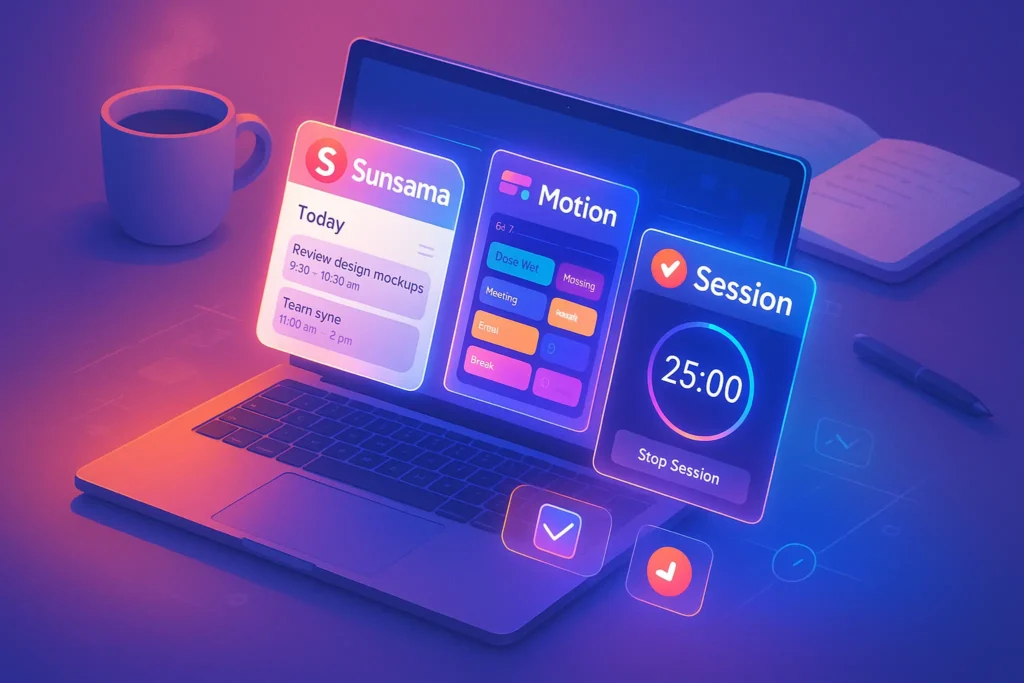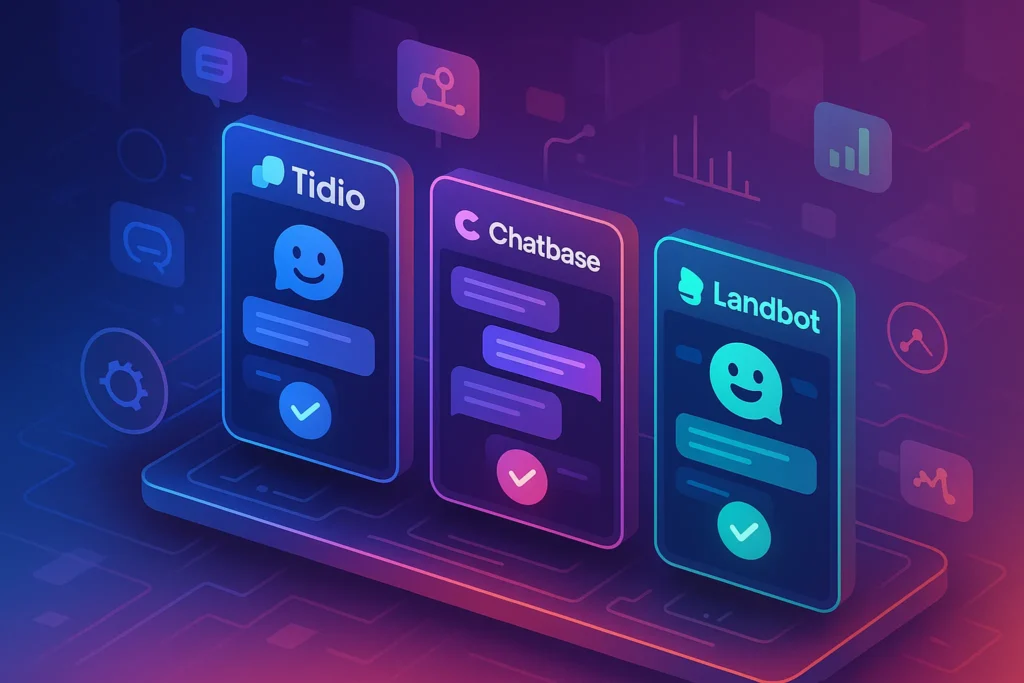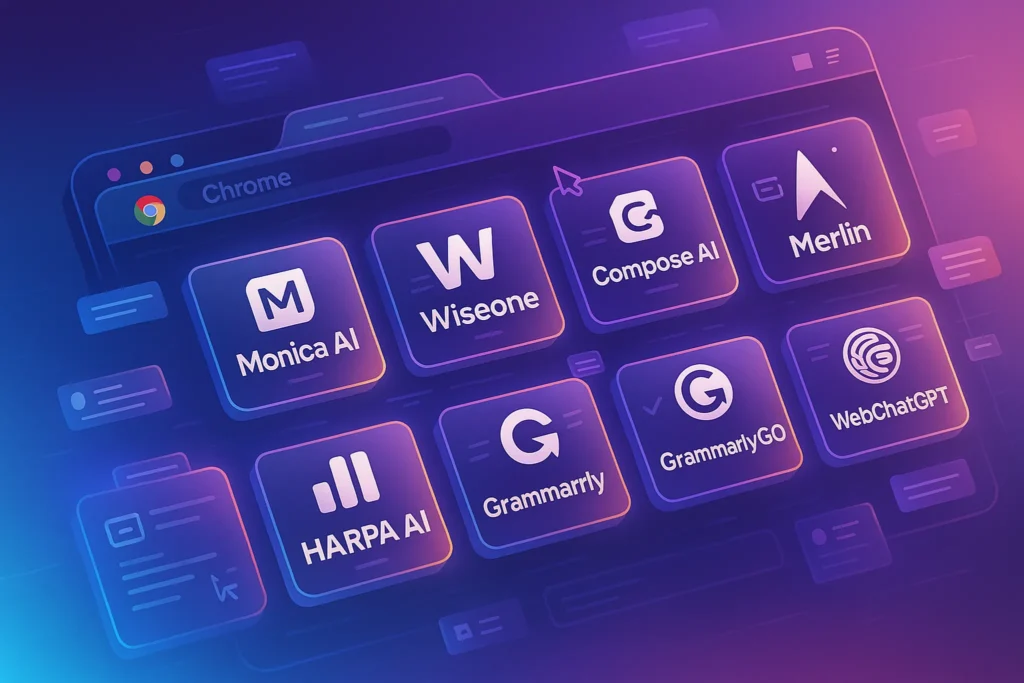-This post may contain affiliate links. If you click on one and make a purchase, I may earn a small commission at no extra cost to you.-
🧭 Introduction
Sticking to old-school tools? In 2025, next-gen apps—AI-powered, mobile-first, and focus-centric—rewrite the productivity playbook. These new tools aren’t about adding more; they’re about working smarter and feeling calmer. As a warm-up, revisit Top Productivity Myths Debunked, then explore a fresh set of apps designed to elevate your daily routines.
🧠 App Spotlights
🚀 Sunsama – Mindful Daily Planning
Imagine starting your day with a calm ceremony: Sunsama opens gently and walks you through selecting 3–5 meaningful tasks. Instead of overwhelmed to-dos, you’re aligning with what matters. It integrates with Notion (including Notion Calendar), Asana, and Trello, so your task board flows into your daily ritual. At dusk, a graceful wrap-up ritual asks, “What went well?” You reflect, log wins, and mentally close the day—shutting your productivity system off in a way that prevents burnout. Sunsama is more than a tool; it’s a thoughtful companion for balanced productivity.
Sunsama marries calm with clarity. Each morning it prompts you to choose top tasks, integrates with your calendar and task tools, and closes the day with a shutdown ritual. Users report feeling less overwhelmed and more in control. Ideal for anyone who wants structure without pressure.
✅ Pros:
-
Calm, ritual-based interface
-
Integrates across major productivity tools
-
Encourages reflection and shut-down
❌ Cons:
-
Higher learning curve for casual users
-
Daily planning may feel too “hands-on” for some
🧠 Motion – AI-Powered Calendar Planning
Motion isn’t just another calendar; it understands your priorities, reschedules intelligently, and adapts in real time. Working on a quarterly goal? Drag it into Motion, and it breaks it into manageable habits and calendar blocks. Caught in a meeting overrun? Motion automatically shifts less-urgent tasks around it. You wake up knowing exactly what the day holds—planned with precision yet flexible to change. For project managers or creatives juggling multiple timelines, Motion keeps you organized and calm.
Motion uses smart AI to auto-schedule your tasks and realign your day in real time. It reallocates tasks if meetings run long, keeps deadlines visible, and cuts out manual rescheduling. Great choice for professionals juggling calendars and to-do lists with precision.
✅ Pros:
-
Dynamic AI calendar adjustments
-
Great for busy professionals
-
Syncs tasks + meetings
❌ Cons:
-
Not ideal for teams needing manual control
-
AI suggestions occasionally feel rigid
📅 Akiflow – Unified Task & Calendar Hub
Akiflow combines email, tasks, calendar, and notes into a central launchpad—no tab switching required. Press a hotkey, jot a task, calendar event, or note, assign a date, and it’s captured. Today’s flow page shows your schedule with built-in execution windows. Prefer keyboard-driven workflows? Akiflow’s setup lets you move blocks, reschedule, and create subtasks entirely by shortcut. For power users, it means efficient capture without distraction.
Akiflow bridges task management and scheduling elegantly. With quick shortcuts, omnichannel capture, and powerful integrations, it becomes your daily hub. Recent comparisons rank it among the top task apps of 2025.
✅ Pros:
-
Fast capture from any app
-
Keyboard shortcuts for everything
-
Clean calendar-task synergy
❌ Cons:
-
Requires manual structure at first
-
Limited team collaboration features
🗓️ Notion Calendar – Smarter Schedule Inside Notion
While Notion has long been a flexible database, the built-in Calendar view finally brings natural scheduling. Drag-and-drop events, peer-collaborate inside calendar blocks, and embed these calendars into dashboards. Team schedules, publication pipelines, or even personal routines—within Notion’s ecosystem, everything stays interconnected. You maintain contextual links: a client meeting note lives next to your calendar card. And it updates instantly within Notion, no external calendar needed.
While Notion is ubiquitous, its calendar add-on brings a breath of fresh UX. Drag-and-drop events inside your workspaces, color-code by project type, and embed deeper workflows without leaving the hub.
✅ Pros:
-
Native to Notion users
-
Clean UX and drag-and-drop events
-
Connected deeply with Notion databases
❌ Cons:
-
Not as advanced as Google/Outlook calendars
-
Still improving recurring event support
💡 Tana / Reflect – Backlink-Based Modern Notes
Tana presents a new paradigm: everything is a block and connections go both ways. You’re crafting notes with embedded tasks, links, and rich data structure. Want to see priorities tagged “#Q2” across projects? Tana surfaces them. Reflect, by contrast, leans into personal insight. Using spaced review, it surfaces ideas you wrote a few days ago—prompting deeper connection and clarity. Both tools respect your brain’s natural linking—helping you write, remember, and act with intention.
Tana and Reflect bring dynamic linking to notes with structured tags, reminders, and relationships. Tana structures your content like a mini-database; Reflect focuses on spaced review and personal insights.
✅ Pros: (Tana):
-
Structured notes with tags and hierarchies
-
Great for project-based thinkers
✅ Pros: (Reflect):
-
Natural note review & memory
-
Zettelkasten-style backlinking
❌ Cons:
-
Limited offline features
-
Steeper learning curve than traditional note apps
⏰ Reclaim.ai – Smart Time Blocking Assistant
Unlike a static calendar, Reclaim learns your work patterns. Start the week by entering tasks and preferences (“Focus after coffee from 9–11”, “Don’t block past 4pm”). Reclaim then places focus slots in gaps between meetings, respects family time, and allows buffer zones. Missed a block? It gently reschedules rather than ignores the delay. Over time, it learns your pace and energy cycles—managing deep work without micromanagement.
Reclaim.ai learns your habits and auto-reserves optimal focus blocks while prioritizing your task goals and energy patterns. Overloaded days? Reclaim subtly reshuffles to avoid burnout while keeping priorities intact.
✅ Pros:
-
AI that adapts to personal routines
-
Automatically defends focus time
-
Integrates with Google Workspace
❌ Cons:
-
Not for users who like full manual control
-
Best results require consistent setup
📝 Routine – Seamless Task + Notes + Calendar
Routine is designed for flow: where tasks are created inside calendar slots, linked to notes, then automatically archived when done. It feels like a cross between Notion, Todoist, and Google Calendar—but without switching contexts. Capture a note in the morning, jot a task during lunch, and start the task with one swipe on your calendar. It removes friction and keeps your flow smooth and connected.
Routine combines tasks, notes, and calendar events in a fluid mobile-first interface. Notes auto-link to tasks; tasks live inside events; and everything syncs across devices—smooth synergy without friction.
✅ Pros:
-
Combines task, note, and calendar
-
Beautiful interface
-
Fast navigation & lightweight
❌ Cons:
-
iOS first – Android users may wait
-
Lacks power-user shortcuts
🍃 Minimalist – Simple iOS Focus Tool
For users who love simplicity on iPhone or iPad, Minimalist gives you a clean interface, distraction-free lists, and Pomodoro presets. Everything syncs with Reminders and Calendar—so you can build a peaceful daily list that respects the Apple ecosystem. The interface is calm, the functions clear, and less is more: no wallpaper dashboards, no extra colors—just your tasks, clearly visible.
Minimalist strips back distractions with a bright, uncluttered list, optional Pomodoro mode, and dark/light themes. It syncs with reminders and calendar, letting iOS fans plan deeply without noise.
✅ Pros:
-
Extremely clean UI
-
Works with Apple Reminders
-
Includes Pomodoro
❌ Cons:
-
iOS only
-
Not suited for complex task management
📈 Session – Pomodoro with Data Insight
Session applies Pomodoro principles, but adds accountability. At the end of each 25-minute cycle, it prompts you to label your focus or distractions (“deep work,” “email,” “distracted by X”). At day’s end, you see charts: where you spend most time, what ate your focus, and how productive you were. It offers real metrics to guide you into better habits—perfect for users looking for mindful productivity through insight.
Session uses Pomodoro timing enriched with power metrics. After work blocks, it visualizes focus trends, distractions logged, and time spent per task—a data-driven boost for disciplined producers.
✅ Pros:
-
Pomodoro plus deep analytics
-
Visualize distraction trends
-
Motivates consistent work blocks
❌ Cons:
-
Works best with strict adherence
-
Less effective for unstructured creative work
📋 Superlist – Wunderlist 2.0 for Teams
Superlist brings the nostalgia of Wunderlist with collaborative features that modern teams need. Shared lists allow teammates to chip off tasks, comment, and track progress in real time. Its clean UX, intelligent reminders, and organized tags make it feel warm and familiar—yet powerful enough for client workflows and team projects. It’s the personal list environment scaled for collaboration.
Superlist revives the beloved Wunderlist experience with modern collaboration: shared lists, real-time updates, tags, attachments, and reminders. It feels familiar but with polished enhancements and privacy control.
✅ Pros:
-
Easy team task sharing
-
Wunderlist familiarity
-
Visual tags and reminders
❌ Cons:
-
Still in early feature development
-
Collaboration better for small teams
🔄 Workflow in Action: Combining Apps
Start with Sunsama to define your top priorities. Let Motion auto-schedule them, then use Akiflow for quick one-off captures. midday, jot ideas in Reflect or Tana. When focus time hits, launch Session to power through, then sync an assisted recap in Routine. When tasks are completed, mark them in Superlist, review tomorrow’s schedule in Notion Calendar, and recharge with a simple checklist from Minimalist. You’ve achieved flow without toggling apps repeatedly.
Here’s how these tools help you stay organized, smooth, and balanced:
-
Morning Boost (Sunsama) – Build your daily ritual by planning work items, syncing with Notion Calendar.
-
Smart Scheduling (Motion/Reclaim) – Let AI pre-allocate meetings and adjust your structure dynamically.
-
Capture & Reflect (Tana/Reflect) – Jot ideas or insights organically, nurtured by backlinked context.
-
Task Execution (Akiflow/Session) – Power through focused action with timers and consolidated task views.
-
Evening Recap (Minimalist/Sunsama) – Review performance using Session’s data or Sunsama’s shutdown review approach.
🎁 Bonus: Choosing the Right App for You
Productivity is personal. Some people thrive with AI-powered calendars, while others find peace in minimalist checklists. If you’re not sure where to start, ask yourself:
-
Do you need help planning your day with clarity? → Try Sunsama or Routine.
-
Want a smart assistant to optimize your schedule? → Motion or Reclaim.ai is your lane.
-
Prefer bulletproof task execution? → Start with Akiflow or Session.
-
Reflective note-taker or thinker? → Tana and Reflect give your brain room to link ideas.
And if you’re deep into time management and want a systemized workflow, check out these next reads:
👉Time Blocking vs Pomodoro – Not sure which method suits your focus style? This post breaks it down
👉 AI To-Do Planning – Learn how AI helps you plan tasks that actually get done
🧠 Nerd Verdict
These carefully curated apps embody next-gen productivity in 2025: intelligent, fluid, and humane. They seek to automate the workflow quietly—giving you space to think and create. Test one, then layer another—your productivity groove is waiting, elegantly crafted for your style.
❓ FAQ
Q: Do I need all these apps?
A: Not at all! Pick one from each category—planning, scheduling, execution—before layering the rest into your workflow.
Q: Are they worth the cost?
A: Most offer free trials. If they save you even 30 minutes each week, they pay for themselves in stress and time.
Q: What about privacy and data export?
A: Tools like Sunsama, Motion, and Reflect support backup/export options. Choose based on your data policy comfort.
Q: Should I use AI apps like Motion and Reclaim immediately?
A: Start with one simple tool like Sunsama. Once the habit is strong, test smart planners. AI-based assistants layer best when your daily rhythm is already stable.
Q: What if these apps overlap?
A: That’s okay. Start with your most-used function—planning, execution, or reflection—and pick the best tool for that. Gradually layer to avoid overwhelm.
💬 Would You Bite?
Which app are you most excited to test? And which ones feel overhyped?
Drop a comment below—I’d love to hear your first pick!👇



